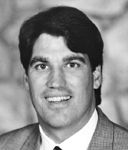Article
Cyclosporine brings rapid relief for mild-to-moderate dry eye
Washington, DC-Initiation of topical cyclosporine 0.05% ophthalmic emulsion (Restasis, Allergan) is associated with rapid onset of relief in most LASIK patients with mild-to-moderate chronic dry eye, said Karl G. Stonecipher, MD, at the annual meeting of the American Society of Cataract and Refractive Surgery.

Dr. Stonecipher reported the results from a subgroup of 44 patients from his practice who were participants in a larger (n = 14,927) real-world study of the efficacy of topical cyclosporine in patients with chronic dry eye. He focused his attention on the 35 patients within his cohort who had undergone LASIK.
The results showed that within 1 week of starting cyclosporine twice daily, nearly one-third of the LASIK patients noted efficacy. By 3 weeks, the proportion of LASIK patients with symptom relief had doubled, and 87% had onset of symptom relief by 5 weeks.
"Whereas it took an average of 4 to 6 months before patients noted efficacy in the FDA clinical trials, onset of symptom relief in this population of LASIK patients with milder disease was much sooner," he said. "With this decreased response time, the role of cyclosporine 0.05% ophthalmic emulsion becomes more important for this subset of patients."
About two-thirds of the 44 subjects in the study were female, consistent with the demographics of the dry eye population in which there is a preponderance of women. About 80% of patients had chronic dry eye for <2 years while the rest had a longer duration of disease.
"That distribution may be endemic to our LASIK-driven practice in which many patients come in seeking refractive surgery because they can no longer tolerate wearing their contact lenses," Dr. Stonecipher explained.
More than half (52%) of the 44 patients were in the 45- to 64-year-old age range, and 39% were age 25 to 44 years. Dr. Stonecipher noted the average age of LASIK patients in his practice is 42.7 years.
Improved ocular comfort
Participants in the study were queried at baseline (prior to initiation of treatment) and after 30 and 60 days via automated telephone surveys. Mean symptom severity was rated on a scale of 0 to 10 with 10 being most severe, and the results showed that by 30 days, mean symptom severity had decreased 25% from a score of 4.69 at baseline to 3.50. Impact of dry eye on daily activities was rated using the same scale and showed a 31% score decrease after 30 days, from 4.25 at baseline to 2.94.
Further demonstrating improvement in ocular comfort, 71% of patients had decreased their daily artificial tear use after starting cyclosporine treatment. No patients reported having to increase their use of artificial tears.
Patient satisfaction was also high with a mean score of 7.44 on a scale of 0 to 10 where 10 represents "very satisfied."
In prescribing cyclosporine ophthalmic emulsion for LASIK patients with dry eye complaints, Dr. Stonecipher considers the severity in determining when to initiate treatment. Individuals considered to have relatively severe disease start cyclosporine treatment 2 to 3 months before undergoing LASIK, and an effort is made to try to schedule their surgery in April or May.
"We have a definite high humidity season during the summer," Dr. Stonecipher said. "Dry eye patients who have LASIK performed during April or May will have the benefit of greater environmental humidity during their postoperative healing period."
For those with moderate dry eye, which includes many perimenopausal females, cyclosporine may be started 1 to 2 weeks after surgery when the therapeutic LASIK regimen is discontinued, he said.
Newsletter
Don’t miss out—get Ophthalmology Times updates on the latest clinical advancements and expert interviews, straight to your inbox.




